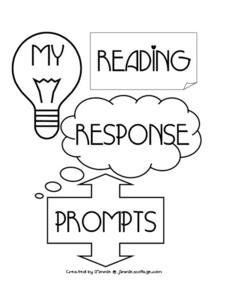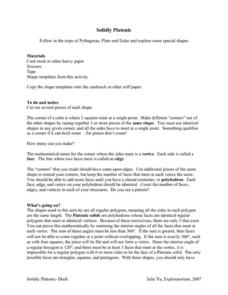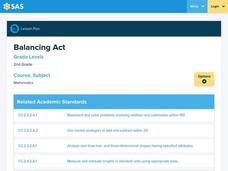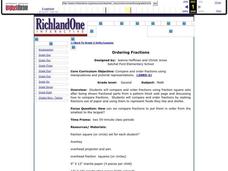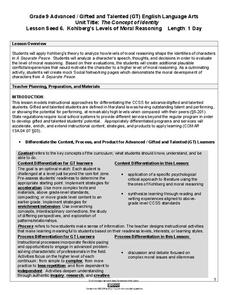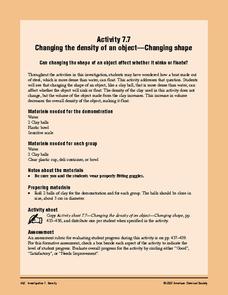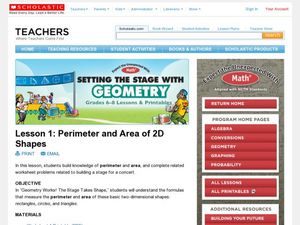Curated OER
Animal Masks
Learners create wonderfully animate animal masks out of balloons. They use the papier-mache technique to create three dimensional animal masks taking care to consider color, shape, texture, and the animals' features.
Curated OER
Soaring Towers
How tall can your tower get? Implement shapes, building strategies, teamwork, and prediction in this interactive tower activity. Learners discuss past experiences with stacking materials, recalling ways they kept it from falling over....
Pennsylvania Department of Education
The Multiplicative Identity and Numbers Close to One
Pupils practice multiplying and dividing whole numbers by fractions. They study the multiplicative identity property that states that the product of any number and 1 is that number. They multiply whole numbers by fractions close to 1 and...
Curated OER
Reading Response Prompts
Get your learners going with frames and starters designed for responding to a text. The starters come in speech bubbles, arrows, and other fun shapes that you can cut out and use in a variety of different ways. Also included are pages...
Curated OER
What a Square
Students examine the painting "Old Man With A Gold Chain" by Rembrandt. They identify geometric shapes in the painting, measure these shapes and compare the relationships of these measurements.
Curated OER
Solidly Platonic
When they do, they learn. Using this resource, young mathematicians learn about platonic solids by actually building, touching, and examining the shapes. They connect their observations about the shapes to Euler's formula.
Curated OER
Solve Word Problems with Geometry
In this geometry worksheet, students solve word problems having to do with lines, angles, shapes, area, perimeter, and more. Students complete 57 problems total.
Pennsylvania Department of Education
Build What I've Created
n this geometric lesson, students define and identify two dimensional shapes based on their attributes. They complete worksheets based on the geometric concepts.
Memorial Art Gallery
Learning to Look, Looking to Learn - Peeling Onions
Lilly Martin Spencer's "Peeling Onions" is the subject of a series of exercises that model for learners how to use the elements of art to read a painting. A series of worksheets focus viewers' attention on how Spencer uses...
Curated OER
Keeping in Shape
Third graders describe patterns in terms of reflection and rotation symmetry, and translations. They design and make a pattern which involves translation, reflection, or rotation. They demonstrate why a given tessellation covers the...
Curated OER
3 dimensional shapes
Students play a bingo game to classify 3 dimensional shapes. In this 3 dimensional shapes lesson plan, students identify, describe, and classify shapes by playing a bingo game.
Curated OER
Balancing Act
Second graders identify the attributes of various shapes and estimate the weight of the objects. In this geometry lesson, 2nd graders identify the attributes of concrete objects and use a pan balance to weight them.
Curated OER
Geometry Straws
Young scholars create different angles and shapes by using different lengths of straws. In this geometry straws lesson plan, students glue straws onto paper and define what they have made.
Pennsylvania Department of Education
A Geometric Scavenger Hunt
Fifth graders connect their knowledge of polygons and polyhedrons. For this geometric shapes lesson, 5th graders identify and classify two- and three-dimensional objects. Students construct a polyhedron out of polygons and describe their...
Curated OER
Ordering Fractions
Second graders use shapes to create various fractions. In this fractions lesson plan, 2nd graders define a fraction, visit a website where they make fractions using various shapes, and use a fraction square set to create and name...
Curated OER
Shape and Figure Descriptions
In this shape and figure worksheet, learners name shapes or figures that are described, then draw a picture of each. A reference web site is given for additional activities.
Maryland Department of Education
The Concept of Identity Lesson 2: The Historical/Biographical Approach
"How does our environment shape our identity?" After researching biographical information about John Knowles and considering how these experiences are reflected in A Separate Peace, class members consider the strengths and weaknesses of...
Maryland Department of Education
The Concept of Identity Lesson 6: Kohlberg's Levels of Moral Reasoning
How does our moral reasoning shape our identity? After a study of Kohlberg's Levels of Moral Reasoning, readers use Kohlberg's theories to analyze the speech, thoughts, and decisions of a character in A Separate Peace. They then...
Curated OER
Pan Balance: Shapes
Students explore the concept of equivalence as it relates to comparing concrete objects to determine greater or lesser attributes such as length and weight. In this pan balance-shapes lesson, students make estimations while verifying...
American Chemical Society
Changing the Density of an Object - Changing Shape
Continuing with the concept of volume and its effect on density, learners now work with a piece of clay to see if they can get it to float in water. This is a memorable end to a seven-part investigation of density. Make sure to check out...
Curated OER
Making Shapes
Tenth graders construct geometric figures using compasses and protractors.
Curated OER
The Shape of Arkansas
Students are shown a United States map and learn the location and shape of Arkansas. They take a map home for their family to help them locate close family members across the United States.
Curated OER
Perimeter and Area of 2D Shapes
Young scholars find the perimeter and area of circles, triangles, and rectangles. In this perimeter and area activity, the teacher gives students formulas for each shape and measurement and works through examples on the board. While no...
Curated OER
Pen and Ink Drawing
Learners hone their drawing techniques to create a nature-inspired piece of art. They practice hatching, cross hatching, stippling, and shading. They discuss how each method is better suited for creating specific elements in nature such...



